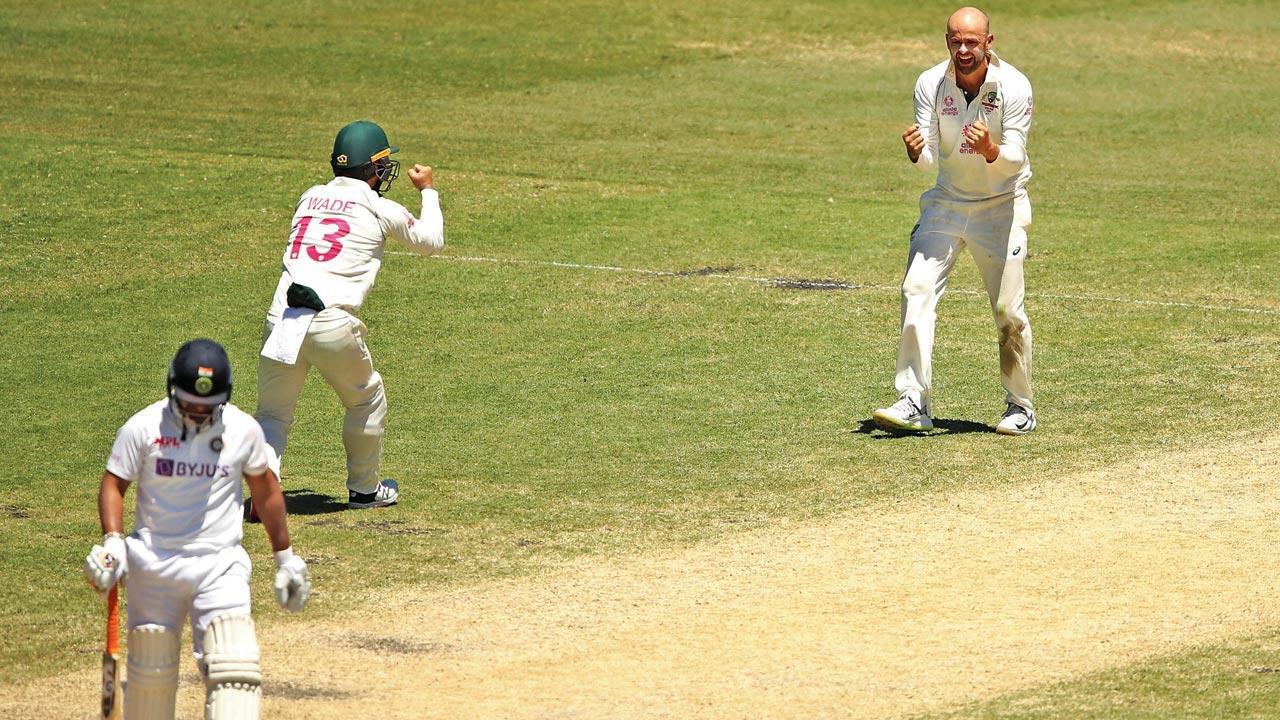It's no longer correct to say India batsmen are the best players of spin bowling. They are not the worst but they're definitely not better. There have been times in this series when they were not smart players of spin

Australia spinner Nathan Lyon (right) celebrates the wicket of India's Rishabh Pant (left), with teammate Matthew Wade during Day Five of the third Test at the Sydney Cricket Ground recently. Pic/Getty Images
![]() In the gripping series between Australia and India it's fair to say the batting—both individual and team— has been indifferent.
In the gripping series between Australia and India it's fair to say the batting—both individual and team— has been indifferent.
ADVERTISEMENT
Finally at the Sydney Cricket Ground (SCG), things regained some form of normality with totals in excess of 300 and Steve Smith finding comfort in his own little batting world. None too soon, with previous totals more often under 200 and even dipping as low as 36; with Ajinkya Rahane's brave Melbourne Cricket Ground (MCG) century an aberration, batting stocks were at a pretty low ebb.
Flat Sydney pitch
The SCG surface was the flattest of the first three Test pitches which adds to the perception that modern batsmen are better at power-hitting than surviving sustained spells of hostile bowling. The truth is more likely there are batsmen in each era more adept at survival than others; it's just there are currently fewer of them because of the drastically changed landscape of the game.
Nevertheless, there are a few aspects of the batting that stand out so far in the series.
First and foremost it's no longer correct to say Indian batsmen are the best players of spin bowling. They may not be worse than some others but they're definitely not better. There have been times in this series when they certainly were not smart players of spin bowling.
In the first innings at the SCG, Rohit Sharma and Cheteshwar Pujara were classic examples. They both plodded forward in defence, ball after ball from Nathan Lyon, which is not only lazy footwork but it's also asking for trouble. Neither was dismissed by Lyon but it was more good fortune than sound footwork.
It was surprising in Pujara's case as his footwork was proactive in the second innings and in playing this way he looked more like the player who dazzled on debut against Australia in 2010.
Generally in the first innings Pujara was very predictable and that played into the hands of the Australian attack. The theory of having Pujara diligently wear down the Australians was a good one on the previous tour when Virat Kohli was there to take advantage but in the skipper's absence the number three had to score more freely.
The Australian batting, despite the emergence of Marnus Labuschagne and the potential of Will Pucovski and Cameron Green, still very much revolves around Smith. Despite five of the six top order positions now being capably filled, the batting looks most serene when Smith is in long-term occupation.
Likewise, the Indian line-up is so much stronger with Kohli in the middle, acting as the batting general. However, they'll be pleased with the emergence of Shubman Gill who not only looks a player of real class but is also a counter-attacking opener; a precious commodity.
To round out India's best side—one that will provide a real challenge if they reach the World Test Championship final—they need Hardik Pandya at full fitness. His all-round presence gives India more selection options in order to take advantage of their blossoming and versatile attack.
The other area of need for India is improved catching; there's no point in having a strong attack if they're constantly thwarted by spilt chances.
That leads to Rishabh Pant's presence as keeper. He's fine standing back but he hurts the team standing up to the spinners. If Pant regularly bats as he did in that spirited second innings knock then he justifies wearing the gloves. However if the standard fare is only quick-fire 30's then there's an argument for Wriddhiman Saha retaining the gloves.
Fragile batting
Nevertheless the fragility of both team's batting has contributed greatly to the enthralling nature of the series. A collapse is never far from reality and consequently neither team has been able to establish absolute authority.
The resilience and fight shown by India has been matched by the class of the Australian attack and their never-say-die attitude. If these two teams reach the final of the World Test championship and they are both at full-strength, it should be one of the great winner-take-all battles.
 Subscribe today by clicking the link and stay updated with the latest news!" Click here!
Subscribe today by clicking the link and stay updated with the latest news!" Click here!






